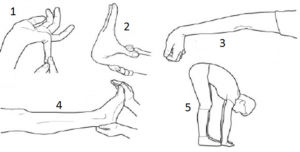5 key strategies for training and rehab in the hypermobile population.
March 24thIf you are like me (someone who has always been as stiff as a brick house), understanding hypermobility took me a while to wrap my head around. Coming from a team sport background, very rarely have I played with hypermobile athletes and it wasn’t until I started coaching female athletes and moved into the Pilates world, that I was heavily exposed to this demographic. People often think of hypermobility as quite a rare condition but it is actually more common than you think, with many people not actually even knowing they have it.
What is hypermobility?
Hypermobility is classified as having excessive laxity at a joint and is assessed and thus categorised at Kinematics using a simple tool, the Beighton Laxity Score, which looks at 5 key regions of the body and gives you a score out of 9 with greater than 4-5/9 meaning you are more than likely hypermobile. Hypermobility is more often seen in females and rarely seen in males (but for you lads out there it can still happen as unbelievable as that may seem), and we can even have isolated hypermobility in certain joints of the body.

The amount of laxity found in a particular joint is multifactorial but in relation to hypermobility, it is more than likely to do with congenital factors (cheers Mum and Dad) or repetitive stress/activities. It is important not to confuse hypermobility with instability, which generally occurs following an injury to a certain joint (i.e the shoulder) and results in uncontrolled, excessive range of motion (ROM).
For various activities or sports that require increased joint ROM, hypermobility can be quite advantageous. However, more often than not the increased joint laxity can subsequently result in a cascade of issues while actively within a sport or following the cessation of these activities. Over the years I have guided athletes and clients with backgrounds in gymnastics, ballet, swimming, even massive ‘yogi’s’ who all experience certain issues as a result of years of repetitive stress. A common theme amongst this population is when they have retired or stopped their sport or activity, the years of repetitive stress and increased laxity accompanied with a newfound lack of strength and control from stopping their sport, brings on a multitude of issues. Sometimes the issues don’t arise until the complete cessation of the sport/activity as there is often a strength and motor control component to all activities that once taken away, inherently decreases the dynamic stability of a joint.
For the general majority of the hypermobile population, addressing the lack of strength and motor control around a joint combined with the minimal understanding of their laxity/ROM, are integral components in reversing longstanding issues and ultimately gaining control in their movement. Therefore, my focus when working with these clients is to educate them on hypermobility in conjunction with aiming to build more strength and control in the musculature around a joint to ultimately reduce the likelihood of detrimental issues.
So enough chit chat! For all the allied health professionals out there, but more importantly for the hypermobile population, here are some tips and tricks for either training or rehab considerations that you can implement:
1. Be aware of where you are meant to feel it
This one is always a tricky topic to discuss as often we see people complete a movement and even though they might be doing it correctly, the person may not “feel” it in the right muscle or region. With hypermobile people, understanding where they are meant to feel an exercise is pivotal as they can often cheat in the movement and access either too much range in the targeted joint or access excess range in other joints to compensate. Educate yourself on where you are meant to feel an exercise and ensure proper technique is executed.
2. Provide external feedback and/or visual cues
By providing external feedback or visual cues, we are able to assist in reminding the Central Nervous System and the person where a certain ROM should start or end. For example, with shoulder flexion using a wall as a signal for the end point of the movement OR taking certain core movements to the floor to encourage lumbopelvic control and avoid dumping into lumbar hyperextension by pressing the lower back into the floor. Even the use of mirrors can be of great use to provide feedback.
3. Program tempo, pauses, isometrics and/or pulses
Arguably the most important tip – add in tempo, isometric holds, pulses or pauses during movements. Hypermobile clients are able to easily access ROM throughout various movements, which often means they bypass the feeling in the musculature and essentially drop in and out of movements effortlessly. By adding in tempo to an exercise like a Goblet Squat with 3 seconds down; 1 second pause at the bottom; 3 seconds up, we are able to create and maintain more time under tension throughout the movement and therefore helping build strength and create more control.
4. Create and maintain tension during movements
Creating more tension of designated muscle groups coincides with point 3. and enables the hypermobile person to exhibit correct technique with targeted muscle activation while reinforcing where an exercise should be felt.
For exercises like the Trap Bar Deadlift, an RDL or even conventional Deadlifts, Lat activation is a pivotal part of being able to competently complete the movement.
Using a Power Band Lat Wrap Around technique that forces the person to engage their Lats for the duration of the movement is a simple way to satisfy creating and maintaining tension through deadlift variations.

5. Stop static stretching and don’t lock out your joints
Many hypermobile people have hyperextended resting postures at various joints like the elbows and knees. Encouraging people to become more aware of these positions and to avoid letting their joints access that hyperextended range is an essential tool in creating more joint awareness and motor control.
Another key strategy is to stop static stretching! This is always a difficult one to get buy-in with because hypermobile people generally do “feel” tight in certain areas, but little do they know that this tightness is caused by a mechanism called “protective tension”. This occurs in such instances where passive structures (like ligaments) are stretched and compromised to the extent that the muscles surrounding the joint work overtime to support and stabilise to the extent that trigger points arise.
Stretching at the time may feel good for the hypermobile person but the recurrent stretching only creates more laxity and instability at the joint. Instead of stretching use soft tissue strategies like trigger point balls and foam rolling!
So there you have it – 5 key strategies for training and rehab in the hypermobile population! If you or anyone you know need help with hypermobility and related issues get in touch today!
By Chris Ross
Physiotherapist + Strength + Pilates | Head of Rehab + Performance
If you would like to book a Physiotherapy or Strength + Conditioning appointment you can do so online here
